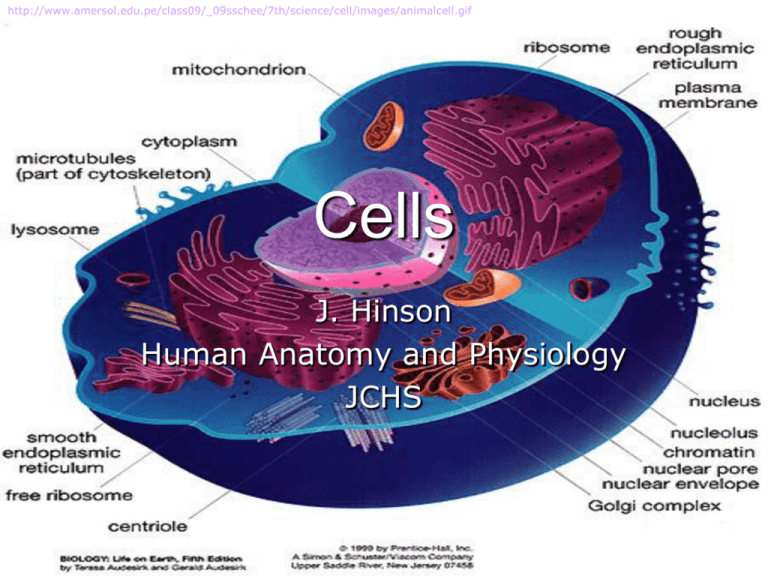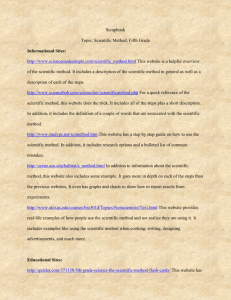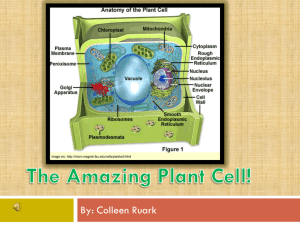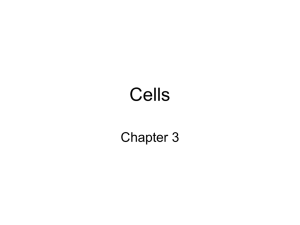Cells
advertisement

http://www.amersol.edu.pe/class09/_09sschee/7th/science/cell/images/animalcell.gif Cells J. Hinson Human Anatomy and Physiology JCHS Introduction 75 trillion cells in the body Vary in size, shape, content, and function –Most common structures: nucleus and cytoplasm http://www.crossroadsinitiativ e.com/pics/Theology_of_the_B ody_Christopher_West_DaVinci .jpg I. The Cell Membrane A. Function: maintains “wholeness”; controls entrance and exit of substances 1. Semipermeable or selectively permeable http://library.thinkquest.org /C004535/media/cell_mem brane.gif I. Cell Membrane B. Structure 1. lipids and proteins 2. Phospholipid bilayer a. hydrophilic phosphate heads b. hydrophobic fatty acid tails 3. oily a. lipid soluble molecules, but not water soluble can freely pass b. embedded cholesterols I. Cell Membrane B. Structure 4. Proteins a. fibrous http://lhs.lps.org/ staff/sputnam/Bio logy/U3Cell/mem brane_1.png b. carrier c.glycoproteins II. Cytoplasm A. jelly-like fluid fills the cell B. Site of metabolic activities http://sciencecity.oupchina.c om.hk/biology/student/gloss ary/img/cytoplasm.jpg http://sun.menloschool.org/~cweaver/cells/c/cytoplasm/jrcytoplasm.jpg III. Organelles A. ENDOPLASMIC RETICULUM 1. Structure: membrane-bound sacs/canals 2. Function: a. Rough: ribosomes site of protein synthesis b. Smooth: lipid synthesis http://www.fairfield.k12. ct.us/tomlinson/ctomlins on03/CellProject04/Per2/ 2MS/endoplasmic_reticul um.jpg http://www.lifesci.susse x.ac.uk/home/Julian_Th orpe/tem3.jpg III. Organelles B. RIBOSOMES http://iup ucbio2.iu pui.edu/a natomy/i mages/Ch apt02/FG 02_11.jpg http://www .rockefeller. edu/rucal/j ourney/ribo somes.gif 1. Structure: a. May be attached or free floating particles b. made of proteins and RNA 2. Function: protein synthesis III. Organelles C. GOLGI APPARATUS http://www.fairfield.k12.ct.us/toml inson/ctomlinson03/CellProject04/ Per2/2JD/golgi.jpg 1. Structure: stack of flattened membranes 2. Function: package and refine proteins 3. Transport vesicles move refined proteins to other cell parts http://biology.unm.edu/ccouncil/Biology_124/Images/golgiapparatusmicroscope.jpeg III. Organelles D. MITOCHONDRIA http://www.abcbo dybuilding.com/m agazine03/mitoch ondria.jpg http://cel lbio.utmb .edu/cell bio/mitm or4.jpg 1. Structure: fluid-filled elongated sac a. Double membrane - cristae: folded layer 2. Function: ENERGY!! III. Organelles E. LYSOSOMES 1. Structure: tiny membranous sac 2. Function: enzymes break down foreign molecules and wastes http://www.visualsunlimited.com/ima ges/watermarked/350/350789.jpg http://www.fairfield.k12.ct.us/tomlinson/ct omlinson03/CellProject04/Per4/4BRL/lysos omes.jpg III. Organelles F. CENTROSOME http://w wwijpb.vers ailles.inr a.fr/en/s gap/equi pes/cyto /images/ centroso me.jpg 1. Structure: near nucleus, 2 hollow cylinders form centrioles 2. Function: role in cellular reproduction III. Organelles G. VESICLES 1. Structure: membranous sac formed by cell membrane 2. Function: move materials throughout cell http://ww wcse.stanfor d.edu/class es/sophom orecollege/pro jects01/cellular automata/ beginning/ vesicles.jp g http://www.visualsunlimited.com/images/ watermarked/284/284900.jpg III. Organelles H. Other cellular structures http://www.uib.no/med/mic /gallery/pictures/SEM/SEMlarge/ciliatedepithelium_870.jpg 1. Cilia a. Structure: short, hair-like projections w/ “to and fro” movements b. Function: movement; Ex: epithelial cells III. Organelles H. Other cellular structures 2. Flagella a. Structure: long, whiplike projection w/ wave-like movements b. Function: movement; Ex: sperm cells http://im ages.live science.c om/imag es/05033 0_sperm _egg_01. jpg http://newsimg.bbc.co.uk/olmedia/4 00000/images/_404096_single_sper m300.jpg III. Organelles H. Other cellular structures 3. Microfilaments a. Structure: tiny protein rods b. Function: cellular movement 4. Microtubules (spindle fibers) a. Structure: thick tubes of protein b. Function: maintain cell structure; strength to motile processes These make up the CYTOSKELETON! CYTOSKELETON http://www.cdli.ca/~dpower/cell/nucleus.jpg IV. The Nucleus 1. Structure: large, spherical; w/in nuclear envelope 1. porous 2. Nucleolus: dense area of ribosome synthesis; ”little nucleus” 3. Chromatin → Chromosomes http://blogofthe.s57.xrea.com/media/1/20040407-nucleus.jpg V. Cell Cycle A. Interphase G1: Growth S: Synthesis of DNA G2: Growth and mitosis prep M: Mitosis (nuclear division) C: Cytokinesis (cytoplasm division) http://www.isd2184.net/~jensenje/biology/BioReviewWeb/U2Re viewWeb/mitosisWeb/Images/Cellcyclediagram.jpg V. Cell Cycle B. MITOSIS 1. Prophase 2. Metaphase 3. Anaphase 4. Telephase http://www.houghtonmifflinbooks.com/booksellers/press_release/studentscience/gif/mitosis1.gif PROPHASE INTERPHASE MITOSIS ANAPHASE METAPHASE TELOPHASE V. Cell Cycle C. CYTOKINESIS Two identical daughter cells formed. http://raven.zoology.washington.edu/celldynamics/research/cytokinesis/images/SdTeloAT.jpg D. DIFFERENTIATION http://training.seer.cancer.gov/ss_ module08_lymph_leuk/images/illu_ blood_cell_lineage.jpg http://training.seer.cancer.gov/ss_module08_lymph_leuk/images/illu_blood_cell_lineage.jpg V. Cellular Movements A. PASSIVE TRANSPORT No cellular energy (ATP) required. 1. Diffusion: molecules move from areas of high concentration to low (down the concentration gradient) a. Equilibrium: solute evenly distributed w/in solvent b. Ex: exchange of O2/CO2 in the lungs D I F F U S I O N http://www.indiana.edu/~phys215/lecture/lecnotes/lecgraphics/diffusion2.gif http://www.physics.umd.edu/lecdem/services/demos/demosi6/i6-23.gif V. Cellular Movements A. PASSIVE TRANSPORT 2. Facilitated Diffusion: carrier protein moves a glucose molecule a. Promoted by insulin http://www.biologiait.arizona.edu/cell_bio/problem_sets/ membranes/graphics/CHANNEL.GIF V. Cellular Movements A. PASSIVE TRANSPORT 3. Osmosis a. Diffusion of water b. Controlled by osmotic pressure c. Three types of solutions (3) (2) http://biology.unm.edu/c council/Biology_124/Ima ges/tonicity1.jpeg (1) OSMOSIS V. Cellular Movements A. PASSIVE TRANSPORT 4. Filtration a. Hydrostatic pressure, like blood pressure, forces molecules through membrane b. Separate solids from water V. Cellular Movements B. ACTIVE TRANSPORT Cellular energy (ATP) required. 1. Active Transport: molecules move from areas of low concentration to high (against the concentration gradient) a. Provides ~ 40% of cells energy b. Protein carrier molecules are used. ACTIVE TRANSPORT http://www.biol ogie.unihamburg.de/bonline/library/bi ology107/bi107 vc/fa99/terry/i mages/ATPpum A.gif V. Cellular Movements B. ACTIVE TRANSPORT 2. Endocytosis: entry of molecules too large to be moved by AT/PT. a. Pinocytosis: membrane pinches inward to take in liquid b. Phagocytosis: membrane pinches inward to take in solid 3. Exocytosis: outward bulge of membrane for large molecule exit Endocytosis vs. http://www.stanford.edu/group/Urchin/GIFS/exocyt.gif Exocytosis Pinocytosis Phagocytosis http://student.ccbcmd.edu/~gkaiser/biotutorials/eustruct/images/pinocyt.gif








